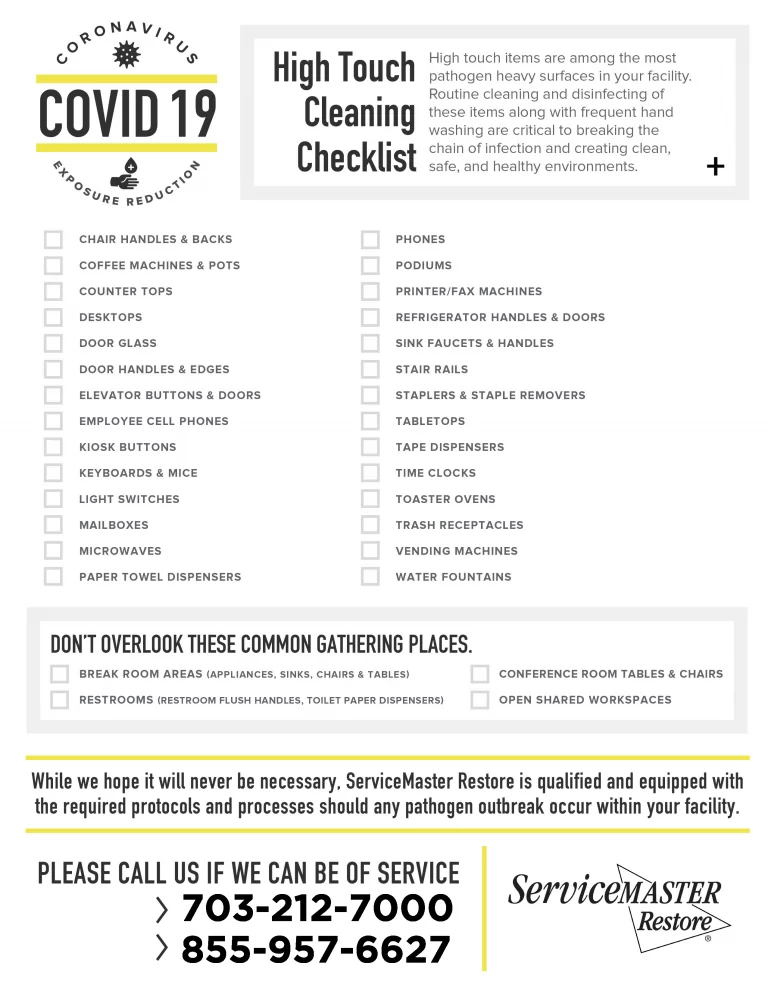Coronavirus, SARS-CoV-2, COVID-19 – a few months ago we didn’t know any of these terms and today they dominate the headlines. Businesses are scrambling to determine how to best protect their employees and customers with the often unexpressed hope of minimal business disruption. In addition to creating a safe work environment, business owners are concerned about the economic impact to their business. This sentiment is further fueled by speculation of a possible economic recession. The following information highlights what you can do to reduce your company’s exposure to COVID-19, and what you can expect in the event your workplace requires disinfection services.
COVID-19 Prevention in the Workplace
We have received many calls from schools, churches, offices, and other commercial businesses looking for disinfection services, or emergency preparedness plans in the event of COVID-19 exposure. While confirmed or suspected exposure often makes these services necessary, there are many steps businesses should be taking to reduce their risk. These include:
♦ Actively encouraging sick employees to stay home. If your employees do not feel comfortable asking, or are concerned they will “get in trouble”, you are more likely to have sick employees come to work and expose others. A good way to show you are serious is to provide paid sick time for self quarantine. Having employees work remotely is a popular alternative.
♦ If your staff often work in close proximity with customers, politely asking if they have been exposed to COVID-19 in order to better protect your employees. You will find that most people appreciate that you are being conscientious.
♦ Instructing employees to wash hands frequently with warm, soapy water for at least 20 seconds, and post signs in restrooms and other highly visible areas to promote good hygiene.
♦ Supplying alcohol-based hand sanitizer that contains at least 60% alcohol if soap and water are not available.
♦ Instructing employees to cough or sneeze in a tissue and disposing of it in a lined trash can or separate bag. If tissue is unavailable, cough or sneeze into your arm, not your hand.
♦ Having janitorial staff disinfect frequently touched objects and surfaces.
♦ Implementing social distancing techniques in the workplace including:
- ⋅ Eliminating handshakes, high-fives, and other physical contact
- ⋅ Keeping a 6 foot distance when possible
- ⋅ Avoid sharing papers and other objects
- ⋅ Carry your own pen for signatures
- ⋅ Eliminating or postponing social functions, company parties, etc.
For additional strategies from the CDC to protect your customers and employees: https://www.cdc.gov/coronavirus/2019-ncov/community/guidance-business-response.htm
Guide to Disinfection Services
In the event that exposure does occur, and professional disinfection services are warranted, it is important to make sure you work with a company that is fully equipped to follow proper safety procedures. Any service taking place requires full Personal Protective Equipment (PPE) if exposure has occurred within the last 24 hours; at this time it is unknown how long viral particles remain suspended in the air. PPE includes full respiratory protection with HEPA filtration, (not just paper masks), Tyvek suits, and impermeable gloves. Suits and gloves must be discarded, NOT reused, and respirators are to be disinfected after each project.
While many people have a tendency to use the following terms interchangeably (cleaning, sanitizing, disinfecting), each term has its own distinct definition. In the case of COVID-19 and other coronavirus, our process is a combination of cleaning surface dirt and impurities, followed by disinfection. In addition to CDC recommendations, there are several additional steps we take in order to increase the effectiveness of our cleaning, while allowing for an emergency response.
How do we accomplish effectiveness?
There are three environmental strategies we employ:
1. It is currently believed that the virus is airborne, but what is unknown is the exact duration it remains in the air. As an additional precautionary measure, we deploy equipment with the goal of neutralizing airborne viral particles while disinfection services are taking place. The most effective measure against viral airborne particles is to increase air exchanges in the building by opening windows and doors, however we understand that for practical purposes this is not always an option.
2. Next, we focus on cleaning and disinfecting of touch surfaces, including but not limited to: door handles and edges, bathroom fixtures and counters, light switches, drinking fountains, keyboards, phones, office equipment, kitchen fixtures, thermostats, alarm panels, chair arms, table tops, desk tops, etc.
3. Finally, we fog with a broad spectrum biocide to ensure a comprehensive treatment of touch surfaces. Note that fogging alone is not effective for thorough disinfection. Cleaning of surface dirt and biofilm is an essential step in this process.
For additional information from the CDC on cleaning and disinfection recommendations: https://www.cdc.gov/coronavirus/2019-ncov/community/organizations/cleaning-disinfection.html
Frequently Asked Questions
1. Can you disinfect or sanitize my upholstery, carpeting, clothing, etc.
While these items can be cleaned, they cannot be disinfected.
2. Do the products you use for disinfection cause staining?
Typically, no. Direct application to fabrics may cause discoloration, but we do not apply our product directly to fabrics. It is possible that some residue may be left behind on hard surfaces after the initial drying period, but these can be wiped away using a damp cloth.
3. Are your products certified for use against COVID-19?
Since SARS-CoV-2 is a new virus, the products used to disinfect must fit the requirements of the EPA’s Emerging Viral Pathogen Policy. All of our disinfection products are eligible under this provision.
4. When can we enter the premises?
We recommend that the space remains unoccupied for 2 hours following treatment to ensure optimal dwell time for the disinfectant.
We will continue to update our protocol and website as more information about COVID-19 becomes available. In the meantime, we encourage everyone to take reasonable preventative measures to prevent the spread of the virus. Thank you for doing your part.

If you have a concern or have an outbreak in your building or facility,
please contact us at (202) 318-2245

